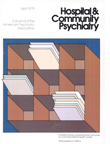The Use of Seclusion on an Inpatient Crisis Intervention Unit
Abstract
Because the use of seclusion is controversial, a retrospective study of 50 patients was designed to examine how seclusion is actually being used on a short-term inpatient crisis Intervention unit. It was found that 44 per cent of the patients were secluded during their stay. Neither sex nor race seemed to be a factor in whether a patient was secluded, but elderly patients and depressed patients were less likely to be secluded. Most of the secluslons occurred on the first day of hospitalization, with the four most common reasons being agitation, uncooperativeness, anger, and history of violence. The author speculates that the use of seclusion on the crisis unit is related to the characteristics of the patient population as well as to the short duration of patient stay.
Access content
To read the fulltext, please use one of the options below to sign in or purchase access.- Personal login
- Institutional Login
- Sign in via OpenAthens
- Register for access
-
Please login/register if you wish to pair your device and check access availability.
Not a subscriber?
PsychiatryOnline subscription options offer access to the DSM-5 library, books, journals, CME, and patient resources. This all-in-one virtual library provides psychiatrists and mental health professionals with key resources for diagnosis, treatment, research, and professional development.
Need more help? PsychiatryOnline Customer Service may be reached by emailing [email protected] or by calling 800-368-5777 (in the U.S.) or 703-907-7322 (outside the U.S.).



